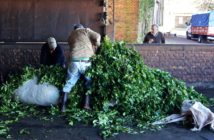The Far East is an area packed with different tea cultures. Not only do most countries in the Orient tend to specialize in certain types of tea, each country prepares it a little different. In other words, that Yellow tea prepared for you in Thailand won't be quite the same as Japanese Yellow tea. Without further ado, here's a list of all the 'big tea players' in the Orient. Each tends to value it in a different way, making the East a wonderful hodgepodge of diverse cultures.
China:
China is where the tea leaf was first discovered, and is widely considered the homeland of it all. In China, tea is a central part of the culture. The act of preparing and drinking tea is mentioned as one of the seven daily necessities of Chinese life. That's dedication!
Tea in China is prepared publicly in Tea Houses across China, and Chinese Tea Houses are strewn through out most towns and cities. They're often filled with students and businesspeople in the late afternoon. In the evening, night owls and insomniacs alike come seeking a place to simply unwind.
Tea is served both hot and cold, and there are often hundreds of different brands and flavors to choose from. The more formal venues offer Chinese and Japanese Tea, and better quality snack food. Vendors also roam the streets, peddling rare or exotic tea leaves, and hand-crafted teaware.
One neat tidbit that gave me a chuckle, was the Chinese Wedding Tea Ceremony. It's a tradition in which couples getting married show respect to their parents through making tea! The bride usually prepares the tea and along with the groom, they serve it to their elders. The parents then will sit drinking the tea, while the bride and groom kneel in front of them. The couple will also receive gifts during the ceremony. When my future kids get married, I want them to do this, too.
Japan:
In Japan, tea is also a piece of the tea culture. In Japan, Green tea is king. It is the traditional form of tea in Japan, and often served during special occasions. Like when an important guest arrives.
A large number of the sweets and snacks in Japan are meant to be enjoyed with Green tea. Visit a typical Japanese restaurant. I guarantee you, Green tea will be the drink of choice to complement sushi and sashimi. The best part? Free refills! The highest quality venues take as much care in choosing the tea they serve as in preparing the main course itself.
The Japanese Tea Ceremony, also known as 'The Way Of The Tea', is a large event in Japan. Powdered Green tea, known as matcha, is prepared. This type of tea ceremony can be so elaborate it's often a performance, called an 'otemae'.
This ceremony takes two forms: The chakai ceremony, and the chaji gathering. A chakai ceremony isn't that complicated; the tea is served, enjoyed, and perhaps a light meal is included.
A chaji gathering is a different story. It is much more lengthy and formal, lasts up to four hours, and features a full meal and a variety of thick and thin Green teas. I recommend only attending a chaji gathering with people whose company you really enjoy.
Most tea in Japan is processed in areas such as the city of Uji in Kyoto Prefecture or the Shizuoka Prefecture. Naturally, most of the tea produced is Green tea. The tea produced is enjoyed in Japan and shipped around the world.
I hope you enjoyed this article. Tea culture is so diverse, educational opportunities are as endless as the flavors. May pleasant memories float to the surface on your next trip to the Orient!
As always, check out the Oriental Tea Bible, as I like to call it. Plenty of reviews, and useful tips and tricks are found within. Also, The Daily Tea online magazine is over-flowing with a wealth of tea-related information, from travel and inspiration, to recipes and wellness.
Bon Voyage!
Paul is an avid tea blogger who hopes to both educate the public and support worthy web sites though informative, useful articles. Having sampled the tea culture, he has settled on Asian tea as his beverage of choice. Stay tuned for more of his articles critiquing everything from puerh to silver needle!


